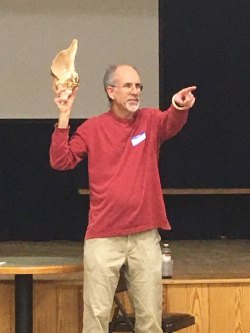The US Lifesaving Service began in the mid 1800’s and then merged with the Revenue Cutter Service in 1915 to form the United States Coast Guard. The Lifesaving Service Had 279 Stations on the coasts of the United States with 29 in North Carolina and two on Ocracoke Island. During its years of operation, the Lifesaving Service saved 28,000 ships in distress and 177,000 people, a success rate of 99%. The surfmen practiced drills six days a week and patrolled the beach 24 hours a day. Given the primitive nature of the equipment and the treacherous conditions of the ocean during storms, the rescues were often very dramatic.

Philip recounted one such rescue, that of the Sarah D.J. Rawson on Cape Lookout in February of 1905. Most of the surfmen were either suffering from or were just recovering from influenza. The ship hit the shoals approximately nine miles off of Cape Lookout on a Thursday evening but due to weather conditions was not spotted until the next day. The lifesaving crew, under the direction of Keeper William Gaskill, reached the ship by the late afternoon but because of waves and floating debris were unable to complete the rescue. The men anchored nearby to wait out the night and on Saturday, when the tide turned, they were able to rescue the remaining crew. The operation had taken 28 hours, and the surfmen, though weakened and sick, gave their own coats to warm the survivors.
The evening’s shell auction was comprised of a donated collection from the estate of Ret. Admiral Jared Michael. He was stationed in Hawaii and his collection spanned the world with many shells from the South Pacific. Member Amy Dick of Hampton, VA noted that the value of the shell is not just in its appearance or condition, but in the identification, which includes information such as the location and depth of water the shell was found. She said that some collectors even want the GPS coordinates for the shells.

The auction on Friday night netted a total of $1,275 with the highest bid of the evening, $150, going for a Junonia, or Juno’s volute, a type of sea snail. In addition to funding the Shell Club activities, some of the money raised by the auctions and raffles goes to a college scholarship fund.
On Saturday morning, many of the Shell Club members traveled to Portsmouth Island in search of shells and other special treasures. When the meeting resumed in the evening, members shared their finds. Although there were many interesting objects displayed, such as a three pound chunk of fossilized whale bone, the “Find of the Day” went to Tammy Zetka of Durham, NC for her tiny Scotch Bonnet. The shell, which was in perfect condition, was less than 1” long. Another notable find for the day went to Bill Bennight of Jacksonville, NC, not for something he found on the beach, but for the pearl that he found in his dinner of fried oysters at Howard’s Pub! The junior find of the day went to Lily Pemberton of Raleigh, NC for her Scotch Bonnet.

Saturday night brought another shell auction, this one a silent auction, as well as a presentation by Dan Minior, an Emergency Room doctor from Kinston, NC. The title of the presentation was Marine Envenomations and Medicine; or in other words, what’s poisonous in the ocean and how to treat it.
Dr. Minior noted that while humans are the most dangerous animal on earth, mosquitoes, which Ocracoke has in abundance, is the the second most dangerous because of the diseases they spread. When it comes to dangerous ocean creatures, most of the truly poisonous animals are found in warmer waters such as the South Pacific. He noted that in North Carolina the dangers are most likely to come from jellyfish, Portuguese man of wars, stingrays, and Coral snakes although contact with sponges and coral can also be toxic. While jellyfish and the man of wars are commonly mistaken for each other, the man of war is actually a colony of organisms.

Along with jellyfish, they transmit poison through contact with the tentacles. The tentacles of a Portuguese man of war are capable of stinging for six weeks after it dies.
According to Dr. Minior, the stingray is responsible for thousands of injuries a year. While the poison is a mild to moderate venom, the greatest danger is injury from the barb on the tail or spine. These puncture wounds can be fatal. Stingrays burrow into the sand so injuries most often occur when people step on them or when trying to remove them from fishing lines.

The Coral snake is found on the beaches on North Carolina, primarily in the more southern part of the state. Often confused with the harmless King snake, Dr. Minior reminded us to look at the coloring: “red on yellow, kill a fellow.” Coral snakes are tiny, with small fangs, and retreat when frightened. However, if they do bite, they hang on!
Dr. Minior stressed that it is important to be safe on the beaches; prevention is key. If you do experience a sting, dousing the area in vinegar (not urine!) and applying heat is very effective for neutralizing most jellyfish stings as well as most other marine poison. For snake bites, seek antivenom. Treat puncture wounds with normal wound care, such as soap and water and possibly antibiotics. He noted that it is important to get help early and that medications such as Tylenol, Motrin and Benadryl can relieve symptoms.

The next meeting of the NC Shell Club will be May 17 & 18 at the Western Point Community Center in Cedar Point, NC. Guests are always welcome. For more information about the NC Shell Club, click here: www.ncshellclub.com
